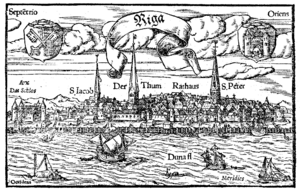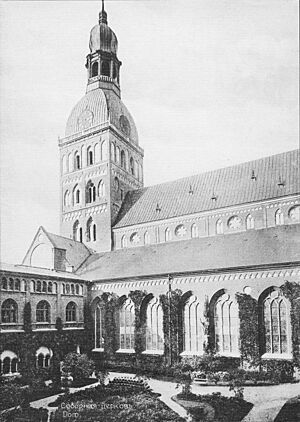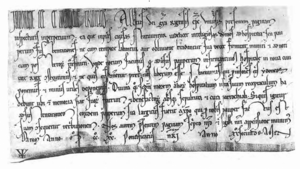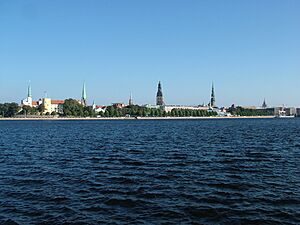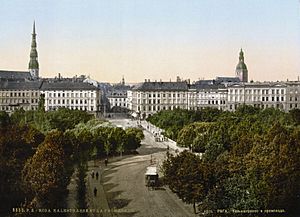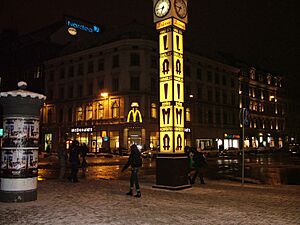History of Riga facts for kids
The history of Riga, the capital city of Latvia, started a very long time ago, around the 2nd century. Back then, it was a small settlement called Duna urbs near a natural harbor on the Daugava River. People like the Livs and Kurs lived there. Riga was already a busy trading spot in the early Middle Ages, connecting to places like Byzantium through the Dvina-Dnieper trade route.
Christianity arrived in Latvia around the 9th century. But it was the Crusades at the end of the 12th century that brought German people and led to many being forced to become Christians. German influence in the Baltic region lasted for a long time, until Latvia became independent. You can still see this German influence in Riga's beautiful Art Nouveau buildings today.
From the 13th century until Latvia gained independence in the 20th century, Riga's story is closely linked with Latvia's. It shows how different foreign powers took control of the land and its people. As a member of the Hanseatic League, Riga became very rich between the 13th and 15th centuries. It grew into a major center for trade and later, for industry, no matter which empire it belonged to.
Today, almost half of Latvia's people live in Riga and its surrounding areas.
UNESCO has named Riga's old town a World Heritage site. This is because of its amazing Art Nouveau buildings, which are considered the best collection in Europe, and its 19th-century wooden buildings.
Contents
How Riga Was Founded
The Daugava River has been an important trade route since ancient times. It was part of the Viking trade route that went all the way to Byzantium. A safe natural harbor, about 15 kilometers upriver from the Daugava's mouth, is where Riga stands today. This area was settled as early as the 2nd century and was known as Duna Urbs. Ancient writings even called Courland a kingdom back then.
Later, the Livs, an old Finnic tribe, arrived in the 5th and 6th centuries. Around the same time, Riga started to become a center for Viking trade during the early Middle Ages.
Archaeological digs in Riga show us what life was like in the 12th century. These digs suggest that Riga was mostly home to the Kurs, Livs, and Kursified Livs from the Daugava river area. They were skilled in crafts, making things from bone, wood, amber, and iron. They also fished, raised animals, and traded goods.
The Chronicle of Henry of Livonia mentions Riga's first recorded defenses on a hill called Senais kalns (meaning "ancient hill"). This hill was later removed in the 18th century. The Chronicle also says that Riga was a trading center by the 12th century, calling it portus antiquus (ancient port). It describes homes and warehouses used to store things like corn, flax, and animal hides.
The name Riga likely comes from the Latvian word rija, which means "warehouse." This makes sense because Riga was a big trading hub. A German historian named Dionysius Fabricius confirmed this in 1610, saying that Riga got its name from the many warehouses along the Daugava River that the Livs called "Rias."
German traders started visiting Riga more often in the late 12th century, coming from Gotland. In 1158, merchants from Bremen who were shipwrecked set up a trading post near Riga. A missionary monk named Meinhard of Segeberg arrived from Gotland in 1184. Christianity had already reached Latvia earlier, but Meinhard's goal was to convert many pagans to Catholicism.
Meinhard settled among the Livs in Ikšķile, about 20 kilometers upstream from Riga. With their help, he built a stone castle and church. This was a new building method for the Livs and helped them build stronger defenses. Hartwig II, the Prince-Archbishop of Bremen, wanted to expand his power north. He made Meinhard the Bishop of Livonia in 1186, with Ikšķile as his main church area.
When the Livs didn't fully give up their old ways, Meinhard tried to force them to convert. But the Livs stopped him from leaving to gather more forces. Meinhard died in Ikšķile in 1196, having failed his mission.
Hartwig then appointed abbot Berthold of Hanover as Meinhard's replacement. In 1198, Berthold arrived with many crusaders and began a campaign to force people to become Christians. Latvian stories say that Berthold was killed in battle by a Liv warrior named Imants.
The Church wanted to get revenge for Berthold's death. Pope Innocent III called for a crusade against the Livonians, promising forgiveness of sins to anyone who joined. Hartwig made his nephew, Albert, Bishop of Livonia in 1199. A year later, Albert arrived in Riga with 23 ships and 500 crusaders. In 1201, he moved the main church center from Ikšķile to Riga, forcing the local elders to agree.
Even today, 1201 is celebrated as the year Albert founded Riga. Later German historians created a story that Germans "discovered" Livonia and brought civilization and religion to the people there.
Riga Becomes a German Trade Hub
Under Bishop Albert's Leadership
The year 1201 was also important because it marked the first time German merchants reached Veliky Novgorod by traveling through the Dvina River and overland.
Albert set up church rule and introduced the Visby code of law, which was a set of rules for trade. To protect his new territory and German trade, a monk named Theodoric of Estonia created the Order of Livonian Brothers of the Sword in 1202. This group was open to both nobles and merchants.
Church history says that the Livonians became Christians by 1206 after being defeated by German forces. The Liv king Kaupo, who had been baptized earlier, was part of the German forces. In 1207, Albert started building defenses for the town. The city gates were first mentioned in 1210. Also, Emperor Philip gave Albert control over Livonia as a territory of the Holy Roman Empire, with Riga as its capital.
The surrounding areas of Livonia also came under the Holy Roman Empire's control. To keep a permanent military presence, the land was divided between the Church and the Order. The Church received Riga and two-thirds of all conquered lands, while the Order received one-third. Before this, crusaders usually served for only a year and then went home.
Albert made sure Riga would be a successful trading city. He got special orders from the Pope that said all German merchants had to trade through Riga. In 1211, Riga made its first coins, and Albert laid the first stone for the Riga Dom. Riga was not yet completely safe, as an alliance of tribes tried to capture it but failed.
In 1212, Albert led a campaign to make Polotsk allow German merchants to use the river freely. Polotsk gave Albert control over Kukenois (Koknese) and Jersika, which Albert had already captured in 1209. This meant Polotsk recognized Albert's power over the Livs and stopped collecting tribute from them.
Opening the Dvina River helped German trade reach further places like Vitebsk, Smolensk, and Novgorod. Riga grew so fast that it became an independent church area in 1213, no longer under Bremen's control.
The oldest parts of Riga were destroyed by a fire in 1215.
In 1220, Albert started a hospital for the poor and sick. In 1225, it became a Holy Ghost Hospital of Germany, though it was meant for lepers, no cases of leprosy were ever recorded there. (In 1330, a new Riga Castle was built on this site.)
Albert's control over both church and government matters started to weaken. Riga's merchants wanted more independence. In 1221, they gained the right to govern Riga themselves and created their own city rules.
That same year, Albert had to accept Danish rule over lands they had conquered in Estonia and Livonia. This happened because the Archbishop of Bremen had closed Lübeck to Baltic trade in 1218. New crusaders couldn't reach Riga, which was still threatened by the Livs. Albert had to ask for help from King Valdemar of Denmark, who also wanted control over the eastern Baltic. The Danes landed in Livonia, built a fortress in Reval (Tallinn), and conquered both Estonian and Livonian land, clashing with the Germans. Albert managed to reach an agreement a year later, and in 1222, Valdemar returned all Livonian lands to Albert.
Albert continued to have problems with Riga's citizens. With help from the Pope, an agreement was reached in 1225. The citizens no longer had to pay taxes to the Bishop of Riga and gained the right to choose their own leaders and city council members.
Albert also focused on Riga's church life. He dedicated the Dom Cathedral, built St. Jacob's Church for the Livonians outside the city walls, and started a school at the Church of St. George, all in 1226. He also regained his earlier losses, conquering Oesel (the island of Saaremaa) in 1227. The city of Riga also made a treaty with the Principality of Smolensk, giving Polotsk to Riga. Albert died in January 1229. Even though he didn't become an archbishop, the German influence he established in the Baltics lasted for seven centuries.
Riga Joins the Hanseatic League
Riga was a key city for trade with the Baltic tribes and with Russia. In 1282, Riga became a member of the Hanseatic League, also known as the Hansa. The Hansa was a group of North German and Baltic cities that worked together for trade and political reasons. It was very successful because it protected its German members' economic interests.
However, the Hansa's policies also created competitors. In 1298, Riga's citizens and the Lithuanian Grand Duke Vytenis made a deal. Pagan Lithuanian soldiers would protect Riga from the Teutonic Knights. This military agreement lasted until 1313.
The Hansa's power began to weaken by the end of the 14th century. Political alliances between Lithuania and Poland, and between Sweden, Denmark, and Norway, reduced its influence. Even so, the Hansa helped Riga gain economic and political stability. This gave the city a strong base that helped it survive many conflicts over the centuries.
As the Hansa's power faded, Riga became a target for other countries that wanted its military, political, religious, and economic advantages. Riga accepted the Protestant Reformation in 1522, which ended the power of the archbishops. In 1524, a respected statue of the Virgin Mary in the Cathedral was called a witch. It was given a "trial by water" in the Daugava River. Since the statue floated, it was declared a witch and burned.
Under Polish-Lithuanian and Swedish Rule
After the Livonian Order fell during the Livonian War, Riga was a Free Imperial City of the Holy Roman Empire for twenty years. Then, in 1581, it came under the control of the Polish–Lithuanian Commonwealth after the Treaty of Drohiczyn ended the war for Riga.
In 1621, during the Polish–Swedish War (1621–1625), Riga and the nearby fortress of Daugavgrīva came under the rule of Gustavus Adolphus, the King of Sweden. He joined the Thirty Years' War not only for political and economic reasons but also to support German Lutheran Protestantism. During the Russo-Swedish War (1656–1658), Riga successfully defended itself against Russian forces.
Riga remained the largest city in the Swedish Empire for a while. During this time, the city kept a lot of its own self-government. In 1710, during the Great Northern War, Russia under Tsar Peter the Great attacked Riga. Riga and other Livonian towns surrendered to Russia, but they mostly kept their special rights. Riga became the capital of the Governorate of Riga. Sweden's power in the north ended, and Russia became the strongest northern power, which was made official by the Treaty of Nystad in 1721.
Riga: An Industrial City in the Russian Empire
By the end of the 19th century, Riga had become one of the most advanced and successful industrial cities in the entire Russian Empire. More than half of the 800,000 industrial workers in the Baltic provinces worked in Riga. By 1900, Riga was the third-largest city in Russia in terms of industrial workers, after Moscow and Saint Petersburg.
Through centuries of wars and changes in power, the Baltic Germans in Riga, who were descendants of Albert's merchants and crusaders, held onto their powerful position. This was true even as the population changed. Riga even used German as its official language until 1891, when Russian language was made the official language in the Baltic provinces. All birth, marriage, and death records were kept in German until that year.
However, Latvians started to become the largest ethnic group in the city in the mid-19th century. By 1897, 45% of the population was Latvian (up from 23.6% in 1867). The rise of a Latvian middle class made Riga a center for the Latvian National Awakening. This movement saw the founding of the Riga Latvian Association in 1868 and the first national song festival in 1873. The nationalist movement of the Young Latvians was followed by the socialist New Current during the city's fast industrial growth. This led to the 1905 Russian Revolution in Riga, led by the Latvian Social Democratic Workers' Party.
Capital of Independent Latvia
The 20th century brought World War I and the effects of the Russian Revolution to Riga. The Imperial German Army marched into Riga in 1917. In 1918, the Treaty of Brest-Litovsk was signed, giving the Baltic countries to Germany as puppet kingdoms. Riga became the capital of the Duchy of Courland and Semigallia. But because of the Armistice with Germany (Compiègne) in November 1918, Germany had to give up that treaty, and so did Russia. This allowed Latvia and the other Baltic States to claim their independence.
After more than 700 years of German, Swedish, and Russian rule, Latvia, with Riga as its capital, declared its independence on November 18, 1918. During the Latvian War of Independence, different groups fought for control of the city. These included the Latvian Socialist Soviet Republic (supported by the Red Army), Freikorps (German soldiers), and the Latvian Provisional Government. You can find more details in the History of Latvia article.
Between the two World Wars (1918–1940), Riga and Latvia started to focus more on countries in Western Europe instead of Russia. A democratic government system with a President was set up. Latvian was made the official language of Latvia. Latvia was also accepted into the League of Nations. The United Kingdom and Germany became Latvia's main trade partners, replacing Russia. As a sign of these changes, Latvia's first Prime Minister, Kārlis Ulmanis, had even studied agriculture in the United States.
During this time, Riga was described as a lively, grand, and impressive city. Visitors even called it the "Paris of the North."
Soviet and Nazi Periods
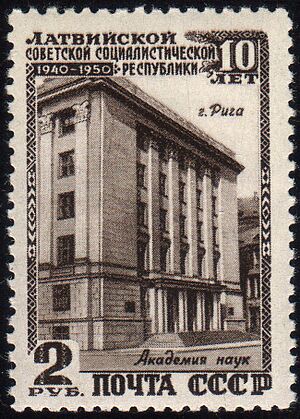
Then came World War II. In 1940, the Soviet Union took over Latvia. Thousands of Latvians were arrested and either executed or sent to harsh labor camps in Siberia, where very few survived. This was followed by German occupation from 1941 to 1944. The Baltic Germans were forced to move back to Germany at Adolf Hitler's command, after living in Riga for 700 years. The city's Jewish community was forced into a ghetto in the Maskavas neighborhood, and people were held in camps in Kaiserwald and nearby Salaspils.
In 1945, Latvia was again controlled by the Soviet Union. Many Latvians were sent to Siberia and other parts of the Soviet Union. They were often accused of working with the Nazis or supporting the anti-Soviet Resistance after the war. The Soviet Union also brought many non-Latvians, especially Russians, to Riga to work in new factories. This changed the population of Riga. Large apartment buildings were built around the city's edge in areas like Purvciems, Zolitūde, and Ziepniekkalns, connected to the center by electric trains. By 1975, less than 40% of Riga's people were ethnically Latvian. This percentage has increased since Latvia became independent again.
In 1986, the modern Riga Radio and TV Tower was finished. Its design looks a bit like the Eiffel Tower.
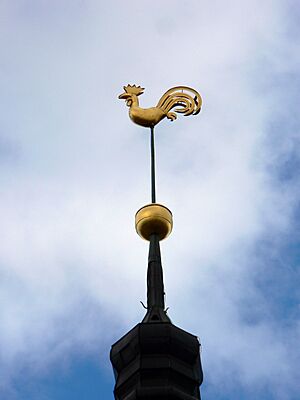
Restoring Independence
The economic changes called Perestroika, started by Soviet leader Mikhail Gorbachev, helped many Soviet republics, including Latvia, regain their freedom in the late 1980s. Although some Latvian cities, including Riga, faced attempts by Soviet OMON forces to restore Soviet power (see The Barricades), Latvia declared its full independence on August 21, 1991. The Soviet Union recognized this independence on September 6, 1991.
In Riga, Soviet street names and monuments were removed. Lenin Prospect became Brīvības (Freedom) Boulevard again, and the Oškalns train station was renamed Zemitani. The statue of Lenin that stood next to the Freedom monument was taken down during celebrations. The highway connecting Riga to Jūrmala was renamed after Kārlis Ulmanis, Latvia's last president before the Soviet era. During this time of political change, some local Russians and Ukrainians lost their citizenship and moved to Russia or other Western countries. Almost all of the Jewish population also left the country. This movement of people helped Riga regain its ethnic Latvian majority. However, some neighborhoods still have a majority Russian population. Joining the European Union, allowing free travel, and rebuilding civil society are slowly bringing Riga back to its diverse roots.
Latvia officially joined the United Nations as an independent country on September 17, 1991. All Russian military forces left Latvia between 1992 and 1994.
- In 2001, Riga celebrated its 800th anniversary as a city.
- On March 29, 2004, Latvia joined NATO.
- On May 1, 2004, Latvia joined the European Union.
- On November 21, 2013, a roof collapsed at a shopping center in Riga. This was Latvia’s worst disaster since independence, killing 54 shoppers and rescue workers.
- On July 1, 2016, Latvia joined the Organisation for Economic Co-operation and Development.
In 2004, the arrival of low-cost airlines made flights from other European cities like London and Berlin cheaper. This led to a big increase in tourists. The number of tourists kept growing, and in 2006, there was an 18% rise in people staying in Latvian hotels compared to 2005. This was the largest increase in the E.U. and much higher than the European average.
Historical Population of Riga
| Historical population of Riga (1767-2020) | ||||||||||||||||||||||||||||||||||||||||||||||||||||||||||||||||||||||||||||||||||||||||||||||||||||||||||||||||||||||||||||||||||||||||||||||||||||||||||||||||||||||||
|---|---|---|---|---|---|---|---|---|---|---|---|---|---|---|---|---|---|---|---|---|---|---|---|---|---|---|---|---|---|---|---|---|---|---|---|---|---|---|---|---|---|---|---|---|---|---|---|---|---|---|---|---|---|---|---|---|---|---|---|---|---|---|---|---|---|---|---|---|---|---|---|---|---|---|---|---|---|---|---|---|---|---|---|---|---|---|---|---|---|---|---|---|---|---|---|---|---|---|---|---|---|---|---|---|---|---|---|---|---|---|---|---|---|---|---|---|---|---|---|---|---|---|---|---|---|---|---|---|---|---|---|---|---|---|---|---|---|---|---|---|---|---|---|---|---|---|---|---|---|---|---|---|---|---|---|---|---|---|---|---|---|---|---|---|---|---|---|---|
|
|
|
|
|||||||||||||||||||||||||||||||||||||||||||||||||||||||||||||||||||||||||||||||||||||||||||||||||||||||||||||||||||||||||||||||||||||||||||||||||||||||||||||||||||||
See also
- History of Latvia
- History of the Jews in Latvia
- Museum of the History of Riga and Navigation
- Siege of Riga, multiple sieges of Riga
- Timeline of Riga


